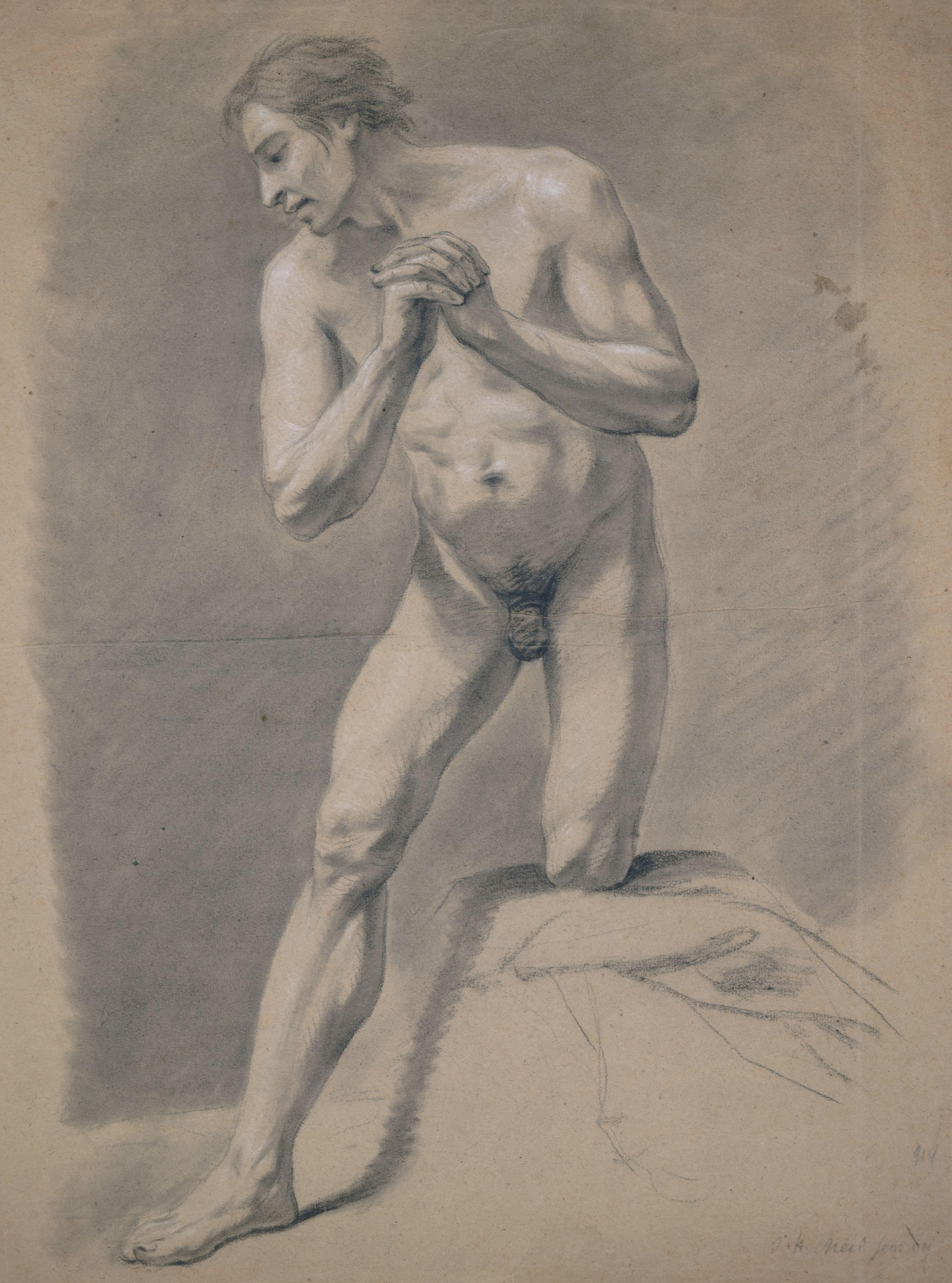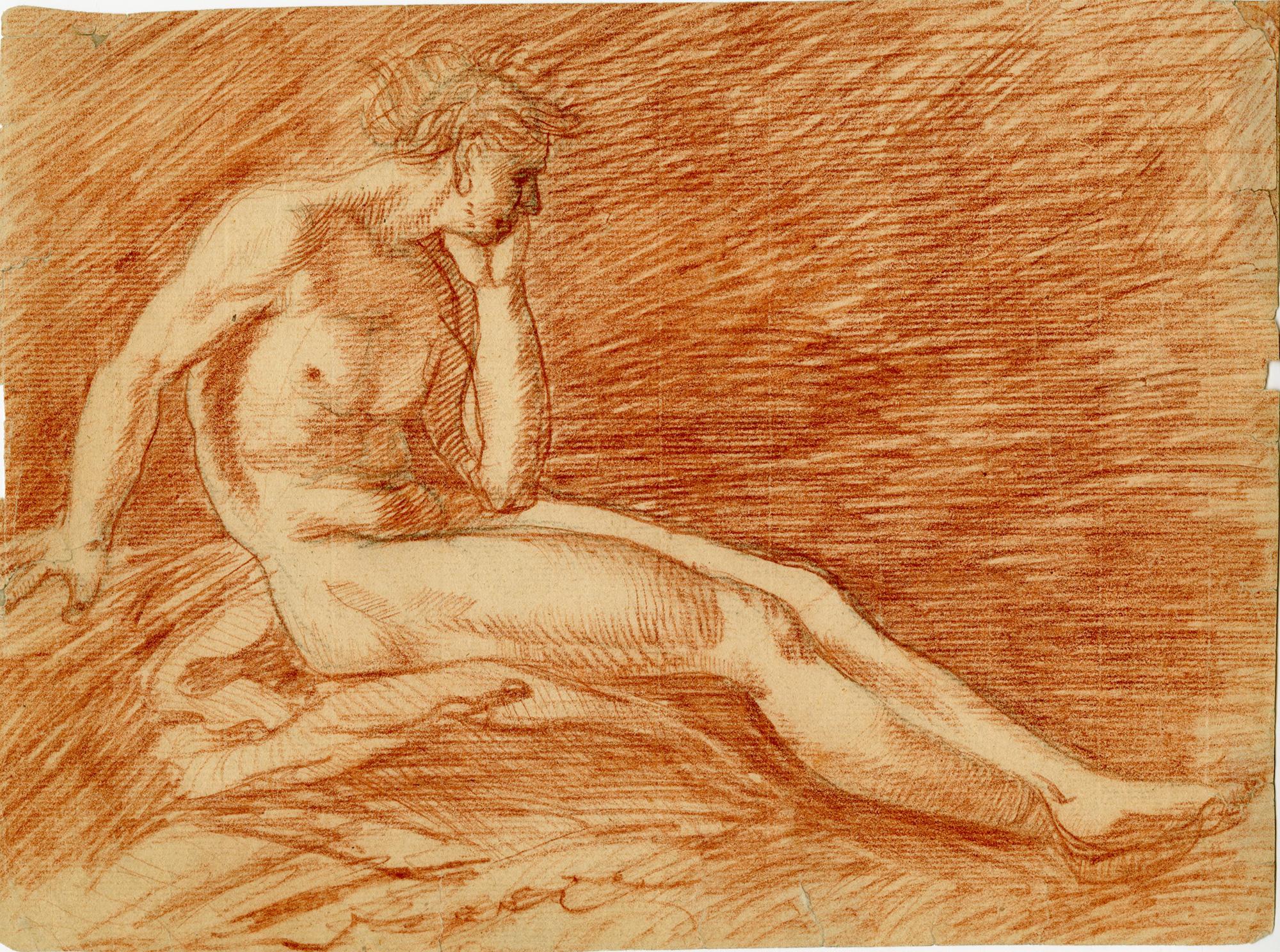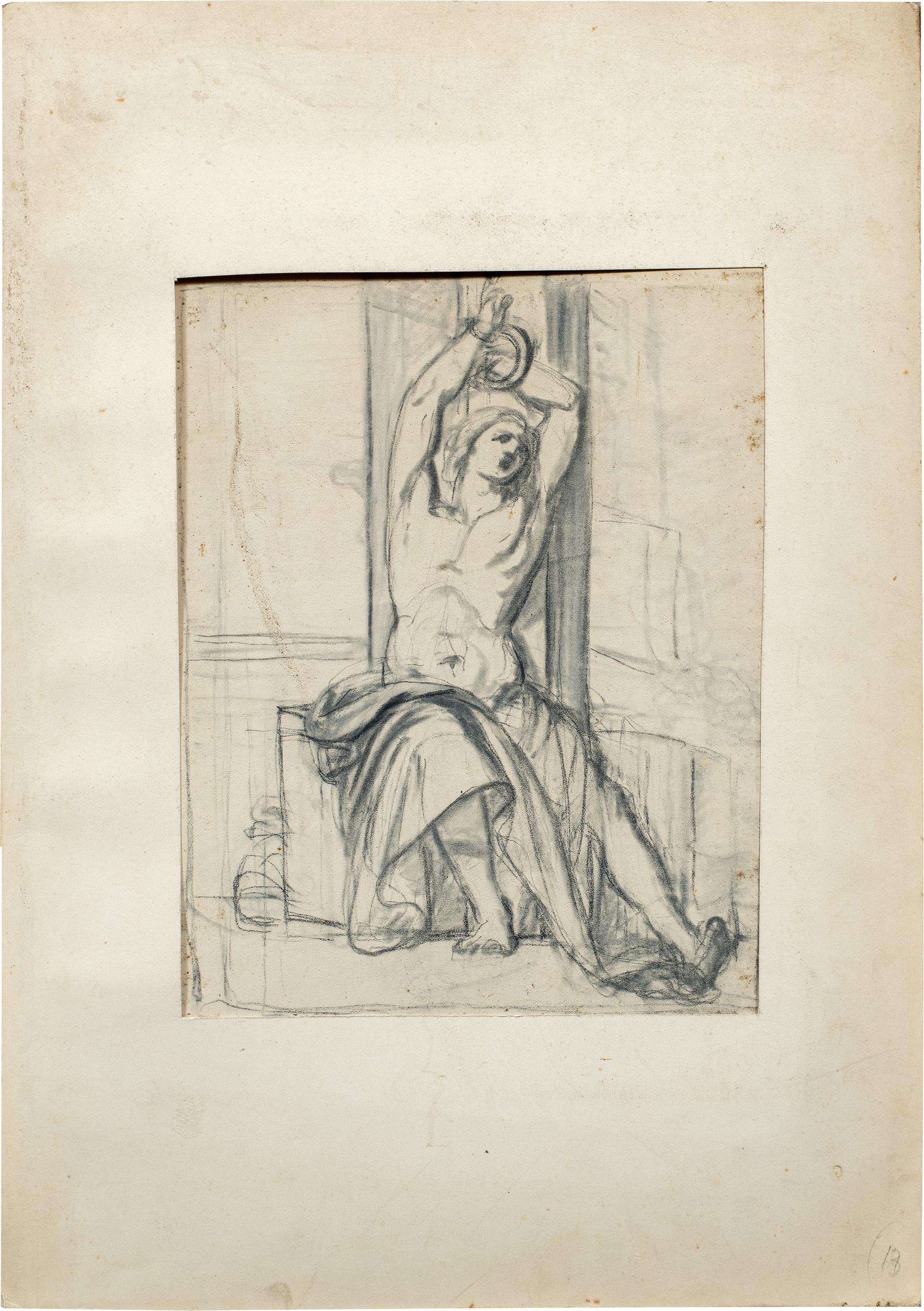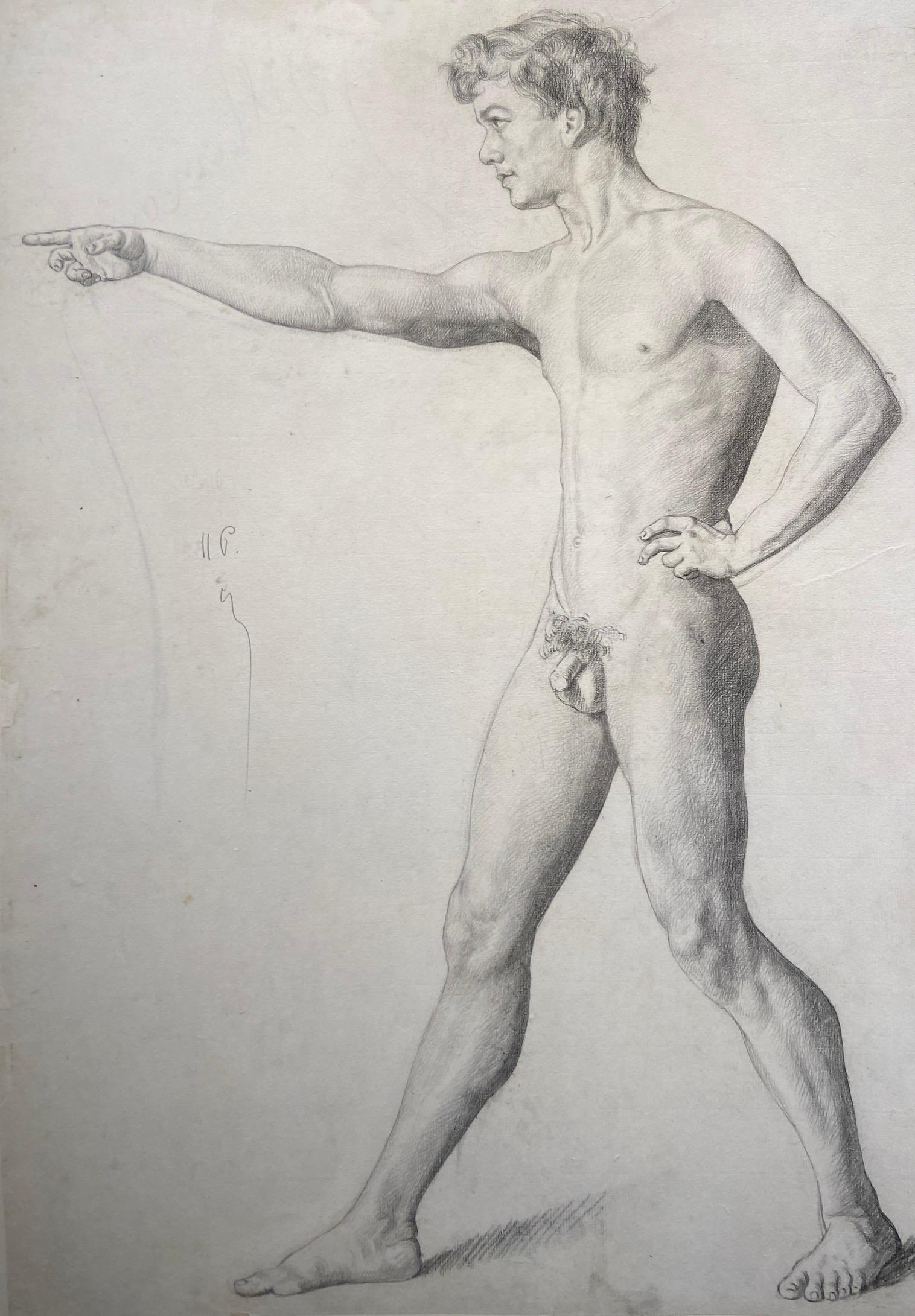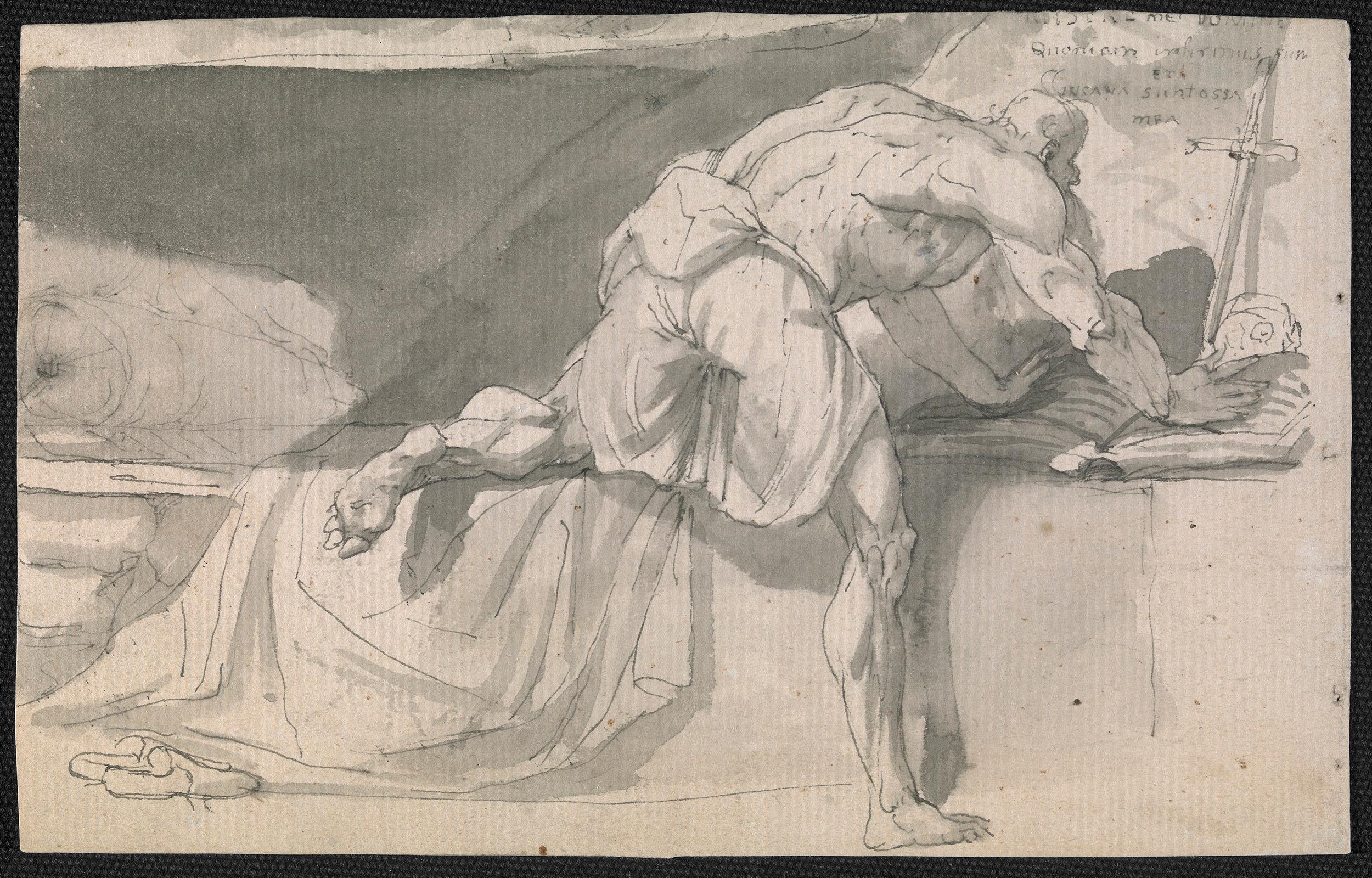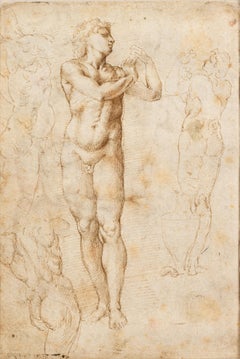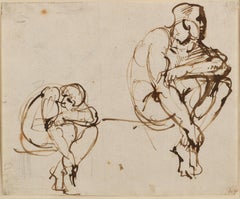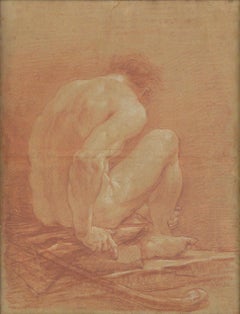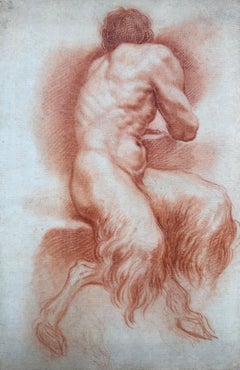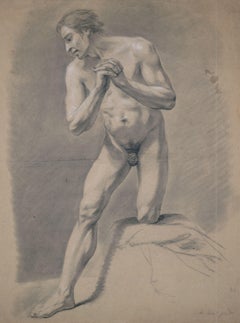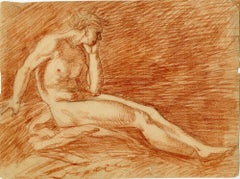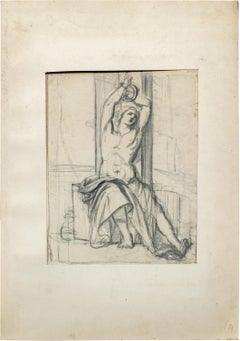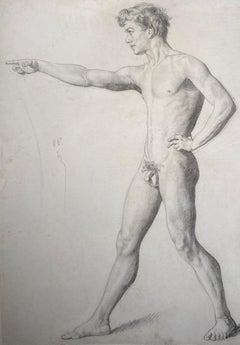Items Similar to Leaning Nude Man (recto); Kneeling Man, Hands Tied Behind His Back (verso)
Want more images or videos?
Request additional images or videos from the seller
1 of 9
Giovanni Francesco Barbieri (Il Guercino)Leaning Nude Man (recto); Kneeling Man, Hands Tied Behind His Back (verso)circa 1625
circa 1625
$80,000
$100,00020% Off
£61,079.64
£76,349.5520% Off
€70,576.98
€88,221.2320% Off
CA$112,304.86
CA$140,381.0720% Off
A$125,175.46
A$156,469.3320% Off
CHF 65,675.27
CHF 82,094.0920% Off
MX$1,528,596.48
MX$1,910,745.6020% Off
NOK 831,591.72
NOK 1,039,489.6520% Off
SEK 785,980.67
SEK 982,475.8320% Off
DKK 526,746.77
DKK 658,433.4620% Off
About the Item
GIOVANNI FRANCESCO BARBIERI, known as GUERCINO
(1591-1666)
Leaning Nude Man (recto); Kneeling Man, Hands Tied Behind His Back (verso)
Black chalk heightened with white on light blue-grey paper 46 x 35.5cm
Provenance:
Private collection, France
Related works:
Recto with the Burial and Assumption of Saint Petronilla by Guercino, painted in 1623 for Saint Peter and now at the Pinacoteca Capitolina, Rome;
Verso with the Martyrdom of Saint James the Greater by Guercino, painted in 1627 for the Cappella Prini in SS. Pietro and Prospero, Reggio Emilia; lost but known from the engraving by Giovanni Battista Pasqualini, Bologna, Pinacoteca Nazionale.
This fascinating double-sided sheet was recently identified as one of Guercino's earliest works by Nicholas Turner.
Our drawing thus belongs to the first phase of Guercino’s activity; strong concordances in style bring it closer to the academies generally attributed to the first period before Guercino visited Rome in 1621 or just after. The physical type set up on the recto of our sheet is found in the Reclining Nude seen from behind, charcoal on beige paper, 35.2 x 46.8 cm, annotated in ink lower right R:C.A R.SM .C, watermark SESTO, Bologna, Pinacoteca Nazionale; or the Seated male nude, torso seen from behind, red chalk heightened with white on beige paper, 33.7 x 27.2 cm, inscription in pencil on the back « Coreggio », Inv. 2536, Dutch Institute, Custodia Foundation, Fritz Lugt collection, Paris.
The liveliness of the recto is reminiscent of two studies by Guercino in Windsor Castle. These drawings from the Royal Collection, with a comparable draughtsmanship, show the same handling
« taken from life »: Nude seated on the ground (recto) and on the right, a study of the lower back and buttocks of a woman, and lower left a pear (verso), circa 1616-20, charcoal and black chalk on greyish-buff paper, 30.0 x 26.3 cm, RCIN 902415; and a Reclining male Nude, circa 1618-19, oiled charcoal, heightened with white, on buff paper, 38.5 x 57.6 cm, RCIN 991227.
Two principal observations regarding the recto of our drawing may be made: first, it is an academy sheet, and secondly, it reveals the obvious influence of Faccini (it can be considered the most important stylistic reference of this period). Study of the live model was a primary concern in the Carracci Academy in Bologna, and therefore also for Guercino, who later embraced this approach in his establishment of an Accademia del Nudo in the Casa Fabri. Nicholas Turner clarifies that the so-called « reform of painting » achieved by the Carracci in Bologna came about from their practice of basing figurative painting on the accurate observation of the human figure through drawing, both in its movement and its expression. One of Carracci’s followers, Pietro Faccini (c. 1562-1602), to whom this drawing was formerly attributed, was especially fond of making large-scale nude studies from the male nude, in black chalk, as here, rather than in red chalk, the medium generally preferred by the Carracci themselves. He was also fond of indicating dark areas in heavily accented marks, indicating the mid-tones in more evenly handled patches of shading, which is also paralleled in the handling of our sheet.
Malvasia refers to Guercino's particular interest in Faccini's drawings, which were shown to him by Padre Antonio Mirandola, the first patron to discover the young artist. Guercino's pre-Roman period charcoal or black chalk drawing indeed shows the direct influence of Faccini's technique and style, particularly in their strong contrasts of light and shadow. This technique of oiled charcoal on tinted
paper was indeed favored by the contemporary and rival of the Carracci, whose drawings were admired by Guercino. The stickiness of the charcoal forbade fine detail and led to a breadth of form and heavy shading, perfectly suited to Guercino's rich early figurative style.
The use of black chalk, rather charcoal, associated with light touches of white chalk is also characteristic of certain early studies by Guercino. The oily and soft black chalk of the recto allows Guercino to drawn in chiaroscuro in drawing and to render his academy of man with life and expressiveness. The artist demonstrates an ability to provide for the specific needs of religious iconography through observation from life using his academies. This ability to meet the specific needs of religious iconography through observation of reality produced compositions really understandable to those who contemplated his paintings in churches. While it is difficult to give precise dates for nude studies from the pre-Roman period since for the most part they were not intended to be preliminary to a finished work of art, they often reveal the artist experimenting with poses that he later used in his paintings.
The pose of the recto is almost consciously difficult, but elegant nonetheless, suggesting that it may have been made for itself. It could indeed have been conceived as an exercise rather than in relation to one of the figures of the composition of the altarpiece of the Prini chapel. As Nicholas Turner points out, Guercino used to make full-fledged life drawings in his early period, which served as examples for his students. These drawings were usually done in black chalk or oiled charcoal, sometimes combining the two, and sometimes heightened with white. They were invariably drawn on tinted paper, gray-blue (the type of paper used here), or buff. They were usually carefully finished, with great attention paid to the figure's musculature and the fall of light across the body.
The male nude in the recto study supports his body on a staff, while touching the ground with his left hand. Both his pose and the way the back of his head is turned towards the viewer recalls the pose of the young gravedigger in the central foreground of Guercino's large altarpiece of the Burial and Assumption of Saint Petronilla, painted in 1623 for Saint -Peter and now in the Pinacoteca Capitolina, Rome. In the present drawing, Guerchin probably recycled the pose of this figure, with modifications, in order to explore, for the benefit of his students, the difficult foreshortening presenting by this daring position for the model.
The attribution to Guercino of this double-sided drawing is confirmed by the study on the verso of a kneeling man, his hands tied behind his back, which is an early representation of this pose, probably from life, for the companion of Saint James in Guercino’s lost altarpiece of the Martyrdom of Saint James the Greater, painted in 1627 for the Cappella Prini in SS. Pietro and Prospero, Reggio Emilia. The artist began the altarpiece while he was still working on his frescoes for the dome of the Cathedral of Plaisance. This lost altarpiece survives, in reverse, in an engraving by Giovanni Battista Pasqualini, dated 1628, in which the saint's companion, bearded and wearing a loin cloth, appears on the left, looking to the right. Guercino also struck this kneeling pose in another more accomplished black chalk drawing on buff paper from the National Pinacoteca in Bologna, but this time from a beardless nude model striking a pose much closer to her final painted equivalent . (inv. no. 3679; 42 x 27 cm. The delicate treatment of light and shade in the Bologna drawing is a good comparison with the treatment of the nude studied on the recto of our sheet.
Likewise, Nicholas Turner points out that the figure of the Saint's companion crops up in many variant poses: those in the Royal Library at Windsor Castle (D. Mahon and N. Turner, The Drawings of Guercino in the Collection of Her Majesty the Queen at Windsor Castle, Cambridge, 1989, pp. 24-25, nos. 46 and 47); the Teylers Museum, Haarlem (C. van Tuyll van Serooskerken, Guercino (1591-1666): Drawings from Dutch Collections, exhibition catalogue, pp. 66-67, n° 19); the Instituto Nazionale della Grafica, Rome (D. Mahon, Guercino, Disegni, exhibition catalogue, Bologna, 1968, no. 112); and the Chrysler Museum, Norfolk, Virginia (E. M. Zafran, One Hundred Drawings in the Chrysler Museum at Norfolk, exhibition catalogue, March to May 1979, p. 14, no. 16).
The artist's technical virtuosity and his ability to achieve extraordinary effects of strength and luminosity are striking in this double-sided sheet, which testifies to his creative and experimental draughtsmanship.
We are grateful to Mr Nicholas Turner, co-author with Carol Plazzota of Drawings by Guercino from British Collections, for confirming the attribution of our drawing and for writing an expert report (dated 23 July 2010).
- Creator:Giovanni Francesco Barbieri (Il Guercino) (1591 - 1666, Italian)
- Creation Year:circa 1625
- Dimensions:Height: 18.12 in (46 cm)Width: 13.98 in (35.5 cm)
- Medium:
- Movement & Style:
- Period:1620-1629
- Condition:
- Gallery Location:Paris, FR
- Reference Number:1stDibs: LU2258215479412
About the Seller
No Reviews Yet
Vetted Professional Seller
Every seller passes strict standards for authenticity and reliability
Established in 2010
1stDibs seller since 2022
- ShippingRetrieving quote...Shipping from: Paris, France
- Return Policy
Authenticity Guarantee
In the unlikely event there’s an issue with an item’s authenticity, contact us within 1 year for a full refund. DetailsMoney-Back Guarantee
If your item is not as described, is damaged in transit, or does not arrive, contact us within 7 days for a full refund. Details24-Hour Cancellation
You have a 24-hour grace period in which to reconsider your purchase, with no questions asked.Vetted Professional Sellers
Our world-class sellers must adhere to strict standards for service and quality, maintaining the integrity of our listings.Price-Match Guarantee
If you find that a seller listed the same item for a lower price elsewhere, we’ll match it.Trusted Global Delivery
Our best-in-class carrier network provides specialized shipping options worldwide, including custom delivery.More From This Seller
View AllStudies of the Galli Statue and of an Ignudo
Located in Paris, Île-de-France
Florentine School, early 16th century
Studies of the Galli Statue and of an Ignudo
Pen and brown ink on laid paper
19.1 × 13 cm
Executed c. 1510–1520
Unsigned
This remarkable doub...
Category
16th Century Old Masters Nude Drawings and Watercolors
Materials
Ink
Studies of seated figures
Located in Paris, Île-de-France
GIUSEPPE BOSSI
(1777-1815)
Studies of seated figures
Pen and ink on paper
18 x 14 cm
Provenance:
Private collection, France
Giuseppe Bossi was an Italian Neoclassical painter, dra...
Category
Early 19th Century Old Masters Nude Drawings and Watercolors
Materials
Ink
Academy Study of a Seated Male Figure Seen from the Back
By Charles Joseph Natoire
Located in Paris, Île-de-France
Attributed to Charles-Joseph NATOIRE (Nîmes 1700 – 1777 Gandolfo)
Academy Study of a Seated Male Figure Seen from the Back
(Youthful study executed around the 1720s–1730s, likely du...
Category
1720s Old Masters Nude Drawings and Watercolors
Materials
Chalk
Study of a Seated Satyr, Seen from Behind
Located in Paris, Île-de-France
Domenico Maria Canuti (1625–1684)
Study of a Seated Satyr, Seen from Behind
Red chalk on laid paper with watermark
39 × 26 cm
Unsigned
Provenance:
Private Collection, France
Note...
Category
Late 17th Century Old Masters Nude Drawings and Watercolors
Materials
Chalk
Academy Drawing of a Man
Located in Paris, Île-de-France
Constance-Marie Charpentier (1767–1849)
Academy Drawing of a Man
Black and white chalk on paper
56 x 43 cm
Provenance:
Private collection
Constance-Marie Charpentier, a student of Jacques-Louis David, distinguished herself in late 18th- and early 19th-century Paris as a highly skilled portraitist. Despite the obstacles faced by female artists of her time, Charpentier gained recognition and was even awarded a gold medal at the 1814 Salon—a rare and significant honor. This work, a male nude academy...
Category
19th Century Old Masters Nude Drawings and Watercolors
Materials
Ink, Chalk
Roman School (circa 1590–1620) - Study Of An Executioner
Located in Paris, Île-de-France
Roman School (circa 1590–1620)
Study of a Male Executioner
Black chalk on laid paper,
275 x 199 mm
Unsigned
Formerly Giancarlo Sestieri Collection
This dynamic figure study, exe...
Category
16th Century Old Masters Nude Drawings and Watercolors
Materials
Chalk, Laid Paper
You May Also Like
Male Nude / - The Drama of the Nude -
Located in Berlin, DE
Johann Heinrich Meil (1730 Gotha - 1820 Berlin), Male Nude, 1807. White heightened, occasionally wiped charcoal drawing on brownish paper, 51 cm x 39.5 cm, signed “J.[ohann] H.[einri...
Category
Early 19th Century Rococo Nude Drawings and Watercolors
Materials
Paper
Life study of a male nude in repose - European School, late 18th Century
Located in Middletown, NY
European School, late 18th century. Red chalk with primo pensiero in graphite on cream laid paper, 8 1/2 x 11 1/2 inches (215 x 293 mm). Scattered light handling wear and multiple s...
Category
Late 18th Century Naturalistic Nude Drawings and Watercolors
Materials
Chalk, Laid Paper, Pencil, Graphite
Antique Italian artist - 18th/19th century figure drawing - St. Sebastian
Located in Varmo, IT
Italian artist (18th-19th century) - Study for a St. Sebastian.
28 x 22 cm. 50 x 35 cm with passepartout.
Ink and pencil drawing on paper, without frame (not signed).
Condition re...
Category
Late 18th Century Baroque Figurative Drawings and Watercolors
Materials
Paper, Pencil
$589 Sale Price
37% Off
Anatomy of Man, Signed Graphite Nude Sketch on Paper, 19th Century French Artist
Located in London, GB
Graphite on laid paper, signed verso and paper watermarks and atelier stamp
Image size: 23 ¾ x 16 ¾ inches (60.25 x 43.5 cm)
Gilt Whistler frame
Leon Bellemont
Born on August 20, 1866, in the family home on rue du Grand-Cloître, Léon Bellemont studied from 1875 to 1883 at the Diderot college, where he was an excellent student. At the same time, he joined the municipal drawing school, where his exceptional predispositions were very quickly noted.
In 1884, at the age of 18, Léon Bellemont left Langres to join Paris and its National School of Decorative Arts, then the prestigious Ecole des Beaux-Arts. There, he followed the teaching of Léon Bonnat, a renowned portraitist, and obtained his first rewards and several prizes. It was in 1892, however, that his artistic career took off, with his first participation in the Salon des artistes français, where he exhibited until 1956.
A landscape and impressionist painter, particularly impressing marine worlds, Léon Bellemont stayed more and more regularly in Brittany at the beginning of the 20th century, where he painted numerous paintings. His notoriety grew, as did the profits from his sales, and the State itself ended up placing a few orders with him. His work “The Breton Faith” was, for example, acquired by the museum in Buenos Aires (Argentina).
Subsequently, always in search of inspiration, Léon Bellemont travelled extensively. He was in Bruges from 1907 to 1909, then traveled across France for several years participating in exhibitions. During the First World War, he settled in Algiers where he remained for several years. He then returned to Paris, worked extensively there and achieved great fame. A socialite, he frequented salons and regularly received his friends Jules Adler...
Category
Late 19th Century French School Nude Drawings and Watercolors
Materials
Laid Paper, Graphite
Eighteenth century Old Master drawing - St Jerome
By John Hamilton Mortimer
Located in London, GB
Pen, ink and wash
Framed dimensions: 9 ½ x 11 ¼ inches
Drawn c. 1763
This small, powerful study shows St Jerome contemplating the bible with a cross and sk...
Category
18th Century Old Masters Figurative Drawings and Watercolors
Materials
Ink, Pen
Classical Roman Nude Man draped in Robes, signed French drawing
Located in Cirencester, Gloucestershire
The Roman Man
French artist, 19th century
pencil drawing on paper, unframed
13 x 11 inches
private collection, France
the painting is in overall good and sound condition - very frag...
Category
19th Century Old Masters Nude Drawings and Watercolors
Materials
Pencil
More Ways To Browse
Falling Man
Black And White Nude Drawing
Large Framed Painting Nude
Nude From Behind
Antique Tie Back
Antique Kneeler
Painting Seated Man
Nude Male Man
Dutch Nude
Old Master Pencil Drawing
Man In Black Suit
Nude Embracing Painting
Young Male Nude
Antique Nude Male
French Male Nude
James Castle
Painting Of A Young Man Nude
French Kneeler
